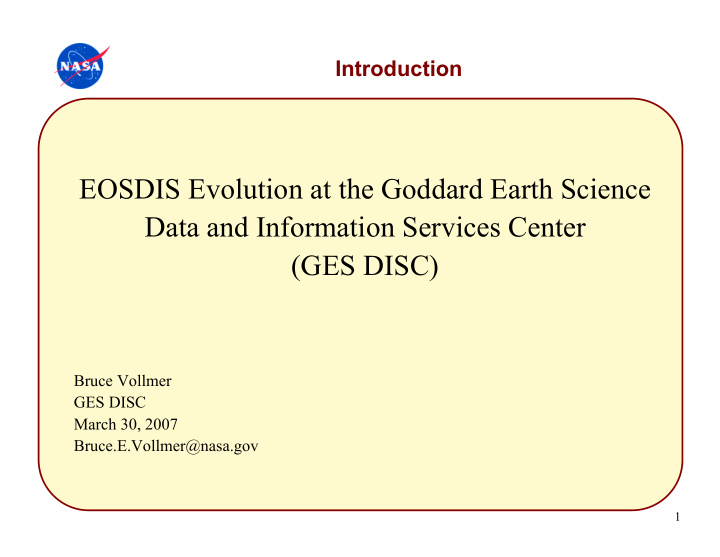



Introduction EOSDIS Evolution at the Goddard Earth Science Data and Information Services Center (GES DISC) Bruce Vollmer GES DISC March 30, 2007 Bruce.E.Vollmer@nasa.gov 1
Outline • Background on EOSDIS Evolution • Evolution activities at the GES DISC • AIRS data in the evolution system – Version 4, Version 5 2
EOSDIS Evolution Background • In early 2005, NASA embarked on an EOSDIS Evolution Study • Address multi-faceted goals/issues: • Manage archive volume growth • Improve science need response and data access • Reduce recurring costs of operations and sustaining engineering • Update aging systems and components • Move towards more distributed environment • A vision for the 2015 timeframe was developed to guide conduct of study (http://eosdis-evolution.gsfc.nasa.gov) • EOSDIS Evolution “Step 1” Plan approved by NASA Headquarters in late 2005. • GES DISC IPR conducted February 2006 3
Basic Approach • Reduce Maintenance and Operations – Reduce off-shift operations (lights out) – Reduce number of different systems (V0, V1, ECS…) • Use dedicated archives for different measurements – Enables measurement (mission)-specific engineering – Reduces risks – Enables fine-grained cost control • Evolve beyond the EOSDIS Core System (ECS) • Get all the data online – Eliminate data latency – Enables services, machine–to-machine access, access via standard protocols • Move to commodity systems – Reduces maintenance and technology refresh costs • Reuse proven software (S4PA) 4
S4PA Software System • Simple Scalable Script-based Science Processor (S4P) Archive • A simplified software system to automate ingest and data management for online data • Based on successful S4P kernel – Operating since 2001 as part of S4PM – Reused for several processing systems – Implements a factory assembly-line paradigm (or DFD) • S4PA – Currently supporting V0 data (2004) and TRMM data (2005) – Written in Perl – Compact: ~20 KSLOC 5
Evolution: DAAC to DISC Consolidate GES DAAC data holdings into one system (S4PA) • Features: – Transition of Aqua AIRS, Aura (HIRDLS, OMI, MLS), SORCE and heritage data sets to S4PA – Transition MODIS archive and L1 processing to MODAPS – Phase out of ECS in early FY08 timeframe • Benefits: – Reduction in operations costs due to elimination of multiple systems – Reduction in archive volume – Reduction in sustaining engineering costs due to use of simpler, scalable software and reduction in dependency on COTS products – Increased system automation due to single system, simpler operational scenarios – Improved data access due to planned use of increased on-line storage and commodity disks/platforms 6
AIRS DISC Architecture airspro4 airsproc3 airsproc3 airsproc3 8 CPU 8 CPU 8 CPU 8 CPU L1-->L3 L1-->L3 L1-->L3 L1-->L3 airscal airspar acdisc airsraw1 4 CPU 4 CPU 8 CPU 4 cpu on-the-fly on-the-fly Giovanni L0->L1 susetting analysis Level 3+ Level 2 Level 0 Level 1 Insulated Level-Slice Architecture + Optimized hardware for each task + Simple reprocessing scheme + User access segregated from processing machines – Significant data movement (Production Network) 7
V4 Status and Plans • Produce and archive 5 year record of V4 L2/L3 data – Through August 2007 • Migrate V4 L2/L3 data from ECS to S4PA • Planned phase out of access to V4 L1 data Dec 2007 (ECS phase out) • Restrict access to V4 L2/L3 data once V5 record is complete – Avoid user confusion 8
V5 Status and Plans • All L0 data migrated from ECS to S4PA • L0 data actively archived in S4PA • V5 L1 Reprocessing underway – 39 X peak rate – 25-30 X rate sustained • V4 L2 benchmarked at 15 X on new system • Target rate of 8-12 X sustained – 6 months to reprocess 5 year record – May 2007 startup – November 2007 completion 9
Conclusion Thank You! Questions? 10
Recommend
More recommend